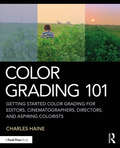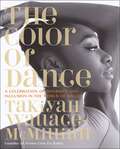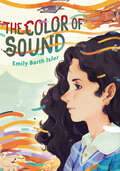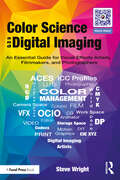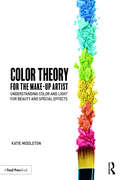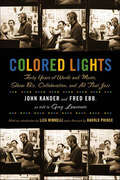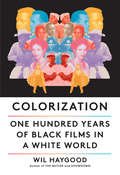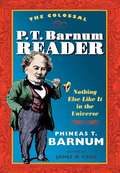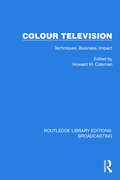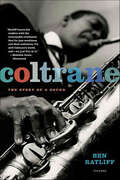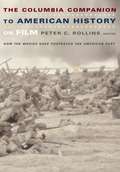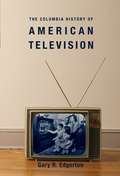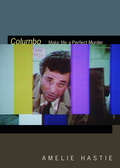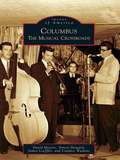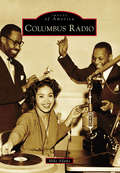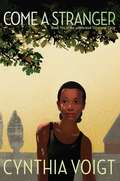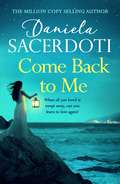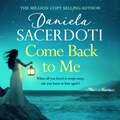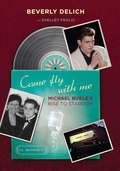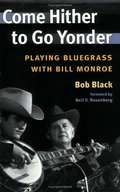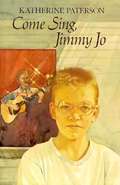- Table View
- List View
Color Dance
by Ann JonasA girl in red, a girl in yellow, a girl in blue, and a boy in black and white are all set to stir up the rainbow. Watch them create a living kaleidoscope, step by step by step.
Color Grading 101: Getting Started Color Grading for Editors, Cinematographers, Directors, and Aspiring Colorists
by Charles HaineWritten both for students and working professionals, this book walks readers step-by-step through the foundations of color grading for projects of any size, from music videos and commercials to full-length features. In this clear, practical, and software-agnostic guide, author Charles Haine introduces readers to the technical and artistic side of color grading and color correction. Color Grading 101 balances technical chapters like color-matching, mastering, and compression with artistic chapters like contrast/affinity, aesthetic trends, and building a color plan. The book also includes more business-focused chapters detailing best practices and expert advice on working with clients, managing a team, working with VFX, and building a business. An accompanying eResource offers downloadable footage and project files to help readers work through the exercises and examples in the book. This book serves as a perfect introduction for aspiring colorists as well as editors, cinematographers, and directors looking to familiarize themselves with the color grading process.
The Color of Dance: A Celebration of Diversity and Inclusion in the World of Ballet
by TaKiyah Wallace-McMillianFrom the photographer behind the Instagram sensation Brown Girls Do Ballet, this stunning coffee-table book showcases breathtaking images of ballerinas of color of all ages and levels that reflect today&’s beautifully diverse world of dance. For decades the prominent image of a ballet dancer has been a white body with pale clothing. It took 75 years for American Ballet Theatre to have its first African American female principal dancer, Misty Copeland. When TaKiyah Wallace-McMillian went to enroll her three-year-old daughter into her first ballet class, she immediately saw this lack of diversity and representation—even on her local dance studio&’s website. Within weeks TaKiyah, a freelance photographer, began shooting a project she called Brown Girls Do Ballet, which eventually became an Instagram hit and a nonprofit organization that provides resources, mentorship, inspiration, and encouragement to young dancers of color worldwide. For her first book, The Color of Dance, TaKiyah traveled around the United States seeking out dancers of African, Asian, East Indian, Hispanic, and Native American ancestry. With these more than 190 breathtaking images of colorful ballerinas of all ages and levels, both amateur and professional, TaKiyah gives a voice to dancers who have been underrepresented for too long. With dozens of quotes throughout from ballerinas themselves, The Color of Dance redefines what this classically Eurocentric art form has looked like for centuries and will inspire dancers—and all of us—to pursue our dreams no matter what barriers are put in front of us.
The Color of Sound
by Emily Barth IslerTwelve-year-old Rosie is a musical prodigy whose synesthesia allows her to see music in colors. She’s never told anyone this, though. She already stands out more than enough as a musical “prodigy” who plays better than most adults. Rosie’s mom expects her to become a professional violinist. But this summer, Rosie refuses to play. She wants to have a break. To make friends and discover new hobbies. To find out who she would be if her life didn’t revolve around the violin. So instead of attending a prestigious summer music camp, Rosie goes with her mom to visit her grandparents. Grandma Florence’s health is failing, Grandpa Jack doesn’t talk much, and Rosie’s mom is furious with her for giving up the violin. But Rosie is determined to make the most of her “strike.” And when she meets a girl who seems distinctly familiar, she knows this summer will be unlike any other. With help from a mysterious glitch in time—plus her grandparents, an improv group, and a new instrument—Rosie uncovers secrets that change how she sees her family, herself, and the music that’s always been part of her.
Color Science and Digital Imaging: An Essential Guide for Visual Effects Artists, Filmmakers and Photographers
by Steve WrightThis book, written by a leading expert in the field of visual effects (VFX), demystifies the complex subject of color science and how it should be managed from project ideation to completion. Readers will learn not only how things work, their capabilities and limitations, but also the color science that goes along with them, in an accessible and informative manner. Starting in the real world, with an understanding of light and our human perception of it, the book then explores how digital cameras "see" and digitize the scene. From the capture of these images, the author then explores the fundamental concerns of storage, editing, and managing color images, including with OpenColorIO and ACES, the Academy Color Encoding System. Written for professional photographers, cinematographers, VFX, motion graphics and computer graphics artists, editors, and colorists, this book will provide you with knowledge of the upstream and downstream technology of your job that will not only give you a competitive advantage and help you to make better images, but also give you a real-world working knowledge of color science.
Color Theory for the Makeup Artist: Understanding Color and Light for Beauty and Special Effects
by Katie MiddletonColor Theory for the Make-up Artist: Understanding Color and Light for Beauty and Special Effects analyzes and explains traditional color theory for fine artists and applies it to the make-up artist. This book is suitable for both professionals and beginners who wish to train their eye further to understand and recognize distinctions in color. It explains why we see color, how to categorize and identify color, relationships between colors, and it relates these concepts to beauty and special effects make-up. The book teaches the reader how to mix flesh tones by using only primary colors, and explains how these colors in paints and make-up are sourced and created. It also discusses the reason for variations in skin colors and undertones, and how to identify and match these using make-up, while choosing flattering colors for the eyes, lips, and cheeks. Colors found inside the body are explained for special effects make-up, like why we bruise, bleed, or appear sick. Ideas and techniques are also described for painting prosthetics, in addition to using color as inspiration in make-up designs. The book also discusses how lighting affects color on film, television, theater, and photography sets, and how to properly light a workspace for successful applications.
Colored Lights: Forty Years of Words and Music, Show Biz, Collaboration, and All That Jazz
by John Kander Fred EbbThe autobiography, in dialogue, of the composer and lyricist of Chicago and Cabaret as well as a wise and witty memoir of forty years of American musicals.Composer John Kander and lyricist Fred Ebb are the longest-running composer-lyricist team in Broadway history, having first joined forces in 1962. The fruits of their collaboration have helped to push American musical theater in a more daring direction both musically and dramatically. At the same time, their impact on individual performers—such as Liza Minelli, who has provided the introduction—has been substantial.Starting with Flora, The Red Menace, their first show together (as well as their first with Liza), and continuing with such groundbreaking works as Cabaret, Chicago, and Kiss of the Spider Woman, Kander and Ebb—ably assisted by Greg Lawrence—discuss their lives and careers with wit and acuity. In exploring the creation of truly original work such as Cabaret, reflecting on what makes a song work, reviewing what they liked (and didn’t like) about the film adaptation of Chicago, and discussing the mechanics of their own collaborative process, Kander and Ebb provide a history not only of their own lives but also of twentieth century American musical theater.Praise for Colored Lights“Anyone who enjoys musical theater will delight in this anecdotal memoir by an accomplished musical team who began their partnership in 1962. . . . Their recollections bring the golden age of musical theater to life and reveal the nuts and bolts of creating a score for a successful musical. The two reminisce freely about stars such as Liza Minnelli, Barbra Streisand and Bob Fosse, with whom they had close working relationships.” —Publishers Weekly
Colorization: One Hundred Years of Black Films in a White World
by Wil HaygoodThis unprecedented history of Black cinema examines 100 years of Black movies—from Gone with the Wind to Blaxploitation films to Black Panther—using the struggles and triumphs of the artists, and the films themselves, as a prism to explore Black culture, civil rights, and racism in America. From the acclaimed author of The Butler and Showdown.Beginning in 1915 with D. W. Griffith's The Birth of a Nation—which glorified the Ku Klux Klan and became Hollywood's first blockbuster—Wil Haygood gives us an incisive, fascinating, little-known history, spanning more than a century, of Black artists in the film business, on-screen and behind the scenes. He makes clear the effects of changing social realities and events on the business of making movies and on what was represented on the screen: from Jim Crow and segregation to white flight and interracial relationships, from the assassination of Malcolm X, to the O. J. Simpson trial, to the Black Lives Matter movement. He considers the films themselves—including Imitation of Life, Gone with the Wind, Porgy and Bess, the Blaxploitation films of the seventies, Do The Right Thing, 12 Years a Slave, and Black Panther. And he brings to new light the careers and significance of a wide range of historic and contemporary figures: Hattie McDaniel, Sidney Poitier, Berry Gordy, Alex Haley, Spike Lee, Billy Dee Willliams, Richard Pryor, Halle Berry, Ava DuVernay, and Jordan Peele, among many others. An important, timely book, Colorization gives us both an unprecedented history of Black cinema and a groundbreaking perspective on racism in modern America.
The Colossal P. T. Barnum Reader: Nothing Else Like It in the Universe
by Phineas T. Barnum James W. CookThe Colossal P. T. Barnum Reader reveals the trailblazing American showman as, by turns, a moral reformer, a habitual hoaxer, an insightful critic, a savvy "puffer," a master of images, a sparkling writer, a relentless provocateur, and an early advocate of "family" entertainments. Taken together, these selections paint a new and more complete portrait of this complex man than has ever been seen before.
Colour Television: Techniques, Business, Impact (Routledge Library Editions: Broadcasting #17)
by H.W. ColemanColour Television (1968) examines the rapid growth of colour television in the 1960s as technological advances enabled programmes to be effectively transmitted in colour for the first time. It looks at the technologies involved, the differences in programme-making that colour required, the audience response, and the changes in advertising and network systems that colour broadcasting brought about.
Coltrane: The Story of a Sound
by Ben RatliffJohn Coltrane left an indelible mark on the world, but what was the essence of his achievement that makes him so prized forty years after his death? What were the factors that helped Coltrane become who he was? And what would a John Coltrane look like now--or are we looking for the wrong signs?In this deftly written, riveting study, New York Times jazz critic Ben Ratliff answers these questions and examines the life of Coltrane, the acclaimed band leader and deeply spiritual man who changed the face of jazz music. Ratliff places jazz among other art forms and within the turbulence of American social history, and he places Coltrane not just among jazz musicians but among the greatest American artists.
The Columbia Companion to America History on Film
by Peter C. RollinsIn this collection, more than seventy scholars examine how filmmakers have presented and interpreted the most important events, topics, eras, and figures in the American past, often comparing the film versions of events with interpretations by leading historians. Divided into eight broad categories-Eras; Wars and Other Major Events; Notable People; Groups; Institutions and Movements; Places; Themes and Topics; and Myths and Heroes-the volume features extensive filmographies (of discussed and relevant films), notes, and bibliographies of selected historical works and is united by a detailed index.
The Columbia Companion to American History on Film: How the Movies Have Portrayed the American Past
by Rollins Peter C. Ed.American history has always been an irresistible source of inspiration for filmmakers, and today, for good or ill, most Americans'sense of the past likely comes more from Hollywood than from the works of historians. In important films such as The Birth of a Nation (1915), Roots (1977), Apocalypse Now (1979), and Saving Private Ryan (1998), how much is entertainment and how much is rooted in historical fact? In The Columbia Companion to American History on Film, more than seventy scholars consider the gap between history and Hollywood. They examine how filmmakers have presented and interpreted the most important events, topics, eras, and figures in the American past, often comparing the film versions of events with the interpretations of the best historians who have explored the topic. Divided into eight broad categories—Eras; Wars and Other Major Events; Notable People; Groups; Institutions and Movements; Places; Themes and Topics; and Myths and Heroes—the volume features extensive cross-references, a filmography (of discussed and relevant films), notes, and a bibliography of selected historical works on each subject. The Columbia Companion to American History on Film is also an important resource for teachers, with extensive information for research or for course development appropriate for both high school and college students.Though each essay reflects the unique body of film and print works covering the subject at hand, every essay addresses several fundamental questions: What are the key films on this topic? What sources did the filmmaker use, and how did the film deviate (or remain true to) its sources? How have film interpretations of a particular historical topic changed, and what sorts of factors—technological, social, political, historiographical—have affected their evolution? Have filmmakers altered the historical record with a view to enhancing drama or to enhance the "truth" of their putative message?
The Columbia History of American Television (Columbia Histories of Modern American Life)
by Gary EdgertonTelevision is a form of media without equal. It has revolutionized the way we learn about and communicate with the world and has reinvented the way we experience ourselves and others. More than just cheap entertainment, TV is an undeniable component of our culture and contains many clues to who we are, what we value, and where we might be headed in the future.Media historian Gary R. Edgerton follows the technological developments and increasing cultural relevance of TV from its prehistory (before 1947) to the Network Era (1948-1975) and the Cable Era (1976-1994). He begins with the laying of the first telegraph line in 1844, which gave rise to the idea that images and sounds could be transmitted over long distances. He then considers the remodeling of television's look and purpose during World War II; the gender, racial, and ethnic components of its early broadcasts and audiences; its transformation of postwar America; and its function in the political life of the country. He talks of the birth of prime time and cable, the influence of innovators like Sylvester "Pat" Weaver, Roone Arledge, and Ted Turner, as well as television's entrance into the international market, describing the ascent of such programs as Dallas and The Cosby Show, and the impact these exports have had on transmitting American culture abroad. Edgerton concludes with a discerning look at our current Digital Era (1995-present) and the new forms of instantaneous communication that continue to change America's social, political, and economic landscape. Richly researched and engaging, Edgerton's history tracks television's growth into a convergent technology, a global industry, a social catalyst, a viable art form, and a complex and dynamic reflection of the American mind and character. It took only ten years for television to penetrate thirty-five million households, and by 1983, the average home kept their set on for more than seven hours a day. The Columbia History of American Television illuminates our complex relationship with this singular medium and provides historical and critical knowledge for understanding TV as a technology, an industry, an art form, and an institutional force.
The Columbia History of American Television
by Gary EdgertonTelevision is a form of media without equal. It has revolutionized the way we learn about and communicate with the world and has reinvented the way we experience ourselves and others. More than just cheap entertainment, TV is an undeniable component of our culture and contains many clues to who we are, what we value, and where we might be headed in the future. Media historian Gary R. Edgerton follows the technological developments and increasing cultural relevance of TV from its prehistory (before 1947) to the Network Era (1948-1975) and the Cable Era (1976-1994). He begins with the laying of the first telegraph line in 1844, which gave rise to the idea that images and sounds could be transmitted over long distances. He then considers the remodeling of television's look and purpose during World War II; the gender, racial, and ethnic components of its early broadcasts and audiences; its transformation of postwar America; and its function in the political life of the country. He talks of the birth of prime time and cable, the influence of innovators like Sylvester "Pat" Weaver, Roone Arledge, and Ted Turner, as well as television's entrance into the international market, describing the ascent of such programs as Dallas and The Cosby Show, and the impact these exports have had on transmitting American culture abroad. Edgerton concludes with a discerning look at our current Digital Era (1995-present) and the new forms of instantaneous communication that continue to change America's social, political, and economic landscape. Richly researched and engaging, Edgerton's history tracks television's growth into a convergent technology, a global industry, a social catalyst, a viable art form, and a complex and dynamic reflection of the American mind and character. It took only ten years for television to penetrate thirty-five million households, and by 1983, the average home kept their set on for more than seven hours a day. The Columbia History of American Television illuminates our complex relationship with this singular medium and provides historical and critical knowledge for understanding TV as a technology, an industry, an art form, and an institutional force.
Columbo: Make Me a Perfect Murder (Spin Offs)
by Amelie HastieFor decades, generations of television fans have been enraptured by Lt. Columbo, played by Peter Falk, as he unravels clues to catch killers who believe they are above the law. In her investigation of the 1970s series cocreated by Richard Levinson and William Link, Amelie Hastie explores television history through an emphasis on issues of stardom, authorship, and its interconnections with classical and New Hollywood cinema. Through close textual analysis, attentive to issues of class relations and connections to other work by Falk as well as Levinson and Link, Columbo: Make Me a Perfect Murder sees American television as an intertextual system, from its origins as a commercial broadcast medium to its iterations within contemporary streaming platforms. Ultimately, Hastie argues, in the titular detective’s constant state of learning about cultural trends and media forms, Columbo offers viewers the opportunity to learn with him and, through his tutelage, to become detectives of television itself.
Columbus: The Musical Crossroads
by Candice Watkins James Loeffler David Meyers Arnett HowardColumbus has long been known for its musicians. Unlike New York, San Francisco, Kansas City, Nashville, or even Cincinnati, however, it has never had a definable "scene." Still, some truly remarkable music has been made in this musical crossroads by the many outstanding musicians who have called it home. Since 1900, Columbus has grown from the 28th- to the 15th-largest city in the United States. During this period, it has developed into a musically vibrant community that has nurtured the talents of such artists as Elsie Janis, Ted Lewis, Nancy Wilson, Rahsaan Roland Kirk, Dwight Yoakam, Bow Wow, and Rascal Flatts. But, in many instances, those who chose to remain at home were as good and, perhaps, even better.
Columbus Radio (Images of America)
by Mike AdamsTwo professors and a preacher invented Columbus radio. It began with science experiments in classrooms and a minister's desire to expand beyond his churchgoing audience. By 1922, government licenses had been issued for WEAO at Ohio State University and WJD at Denison University. At this same time, a Baptist minister went on the air for an hour each Sunday morning using a 10-watt transmitter licensed as WMAN. In this story of Columbus radio, the work of the professors and the preacher will evolve into radio with advertiser-supported programs of information and entertainment. Three important radio stations will serve a growing Columbus radio audience in different ways: WEAO becomes WOSU, a national pioneer in using radio for teaching; WMAN becomes WCOL and in the 1960s is number one in audience size; and CBS affiliate WBNS becomes the class act of Columbus radio, retaining the major share of local listeners for many decades. Including many other stations of lesser influence, the illustrated stories of Columbus radio are told in this book.
Come a Stranger (The Tillerman Cycle #5)
by Cynthia VoigtA dashed dream leads to a rash decision in the fifth installment of Cynthia Voigt’s Tillerman cycle.Mina Smiths lives to dance, so her scholarship to ballet camp seems like a dream come true. She doesn&’t even mind being the only black girl in the troupe—that is, until she is told she&’ll never be a classical dancer. It&’s then that Mina begins to face some difficult truths about race and identity and transfers her passion for dance to Tamer Shipp, the summer minister for her church. The problem is, he&’s a grown man with a family, but she can&’t stop wishing for more to their friendship than simply pastor and parishioner. Cynthia Voigt&’s incomparable mastery of character and community shines forth in this stirring novel from her acclaimed Tillerman cycle.
Come Back to Me (A Seal Island novel): A gripping love story from the author of THE ITALIAN VILLA
by Daniela SacerdotiFrom the bestselling author of The Italian Villa and Watch Over Me, a romantic, moving and uplifting story of three different lives, connected by a thread. Perfect for anyone who loves Fiona Valpy and Lily Graham.'Atmospheric, romantic and compelling. Daniela writes with huge warmth and sincerity' Rosanna LeyThree separate lives. Three broken hearts.Haunted by his wife's death, Matt arrives on Seal Island determined to be alone and unable to escape his grief. In the island's hospital, a young woman named Rose lies in a coma, trapped by the memories of events leading up to her accident. Grace, the island's doctor, is at the heart of the community. Only she knows how much she regrets turning down the chance of love and a family years ago.For these three people hope seems gone. But life is about to offer an unexpected new beginning...Readers adore the captivating novels of Daniela Sacerdoti'A love story that will satisfy even the most hopeless romantics' Daily Express'Beautifully written and atmospheric' The Sun 'A great book' Lesley Pearse'Emotional. I couldn't put it down' Daily Mail'I fell in love with this book' Prima magazine
Come Back to Me (A Seal Island novel): A gripping love story from the author of THE ITALIAN VILLA
by Daniela SacerdotiFrom the bestselling author of WATCH OVER ME, Daniela Sacerdoti's latest Seal Island novel is a romantic, moving and uplifting story of three different lives, connected by a thread.** Over 1 million copies sold of Daniela Sacerdoti's novels **When all seems lost...Matt - grief-stricken after his beloved wife's death, he arrives on Seal Island desperate to hide from the world.Grace - the island's doctor believes she's left it too late to find love or have a family.Rose - lying in a coma at a hospital on Seal, a young woman fights for her life, recalling the journey that led to her accident. ...life can surprise you with a new beginning.(P)2019 Headline Publishing Group Ltd
Come Fly with Me
by Shelley Fralic Beverly DelichIn 1993, Beverly Delich discovered an 18-year-old singer named Michael Bublé in a Vancouver talent contest, became his manager, and moved with him to Toronto, and then L.A., as he tried to break into a tough, unforgiving business. This book is her vivid, behind-the-scenes story of the making of a modern-day superstar, from the early days when she and Bublé struggled to get bookings, to the giddiness of hobnobbing with musical royalty, to the pivotal and sometimes heartbreaking decisions that would take Bublé to the top and found Beverly on the sidelines.
Come guadagnare comparendo in spot pubblicitari e soap opera
by Bernard Levine Simona TrapaniAvete mai desiderato di lavorare come comparse in spot pubblicitari per la tv?...ad esempio per gli spot dei cellulari Samsung o Nokia, del McDonald's o della Coca Cola. Vi piacerebbe partecipare a una soap opera o a una serie tv? Adesso potete realizzare i vostri sogni. È molto divertente e, con il denaro che guadagnerete, ne varrà davvero la pena!
Come Hither To Go Yonder: Playing Bluegrass With Bill Monroe
by Bob BlackFrom the book: Bill Monroe was such a unique, complex, larger than life figure that the impact of his music and his person may still not have fully sunk in even almost 10 years after his death. There will surely be other books about Monroe in the future, but happily we can add this title to the 3 or 4 others already written about the man. Most recently, Butch Robins put out a provocative summation of his years as a banjo player, focusing heavily on his two stints as a Blue Grass Boy. Curiously, the writer of this new volume is also a banjo player, although of an entirely different background and temperament. This book concentrates on the 3-year period (1974-1976) when Black was Monroe's banjo player-and a good one. The book is an easy and very enjoyable read, filled with anecdotes and serious glimpses of life on the road with the legendary band leader. Any fan of Monroe will surely enjoy this well-written book. With Foreword written by Neil V. Rosenberg, author of "Bluegrass: A History." This volume also includes a complete listing of Bob Black's appearances with Monroe, his most memorable experiences while they worked together, brief descriptions of the more important musicians and bands mentioned, and suggestions for further reading and listening. Offering a rare perspective on the creative forces that drove one of America's greatest composers and musical innovators, Come Hither to Go Yonder will deeply reward any fans of Bill Monroe, of bluegrass, or of American vernacular music. FROM AUTHOR'S WEBSITE: "Being a bluegrass banjo player and Monroe fan for most of my life, I found it easy to project myself into the situations and encounters that Black describes. This is a stimulating and thoroughly enjoyable book that I would recommend to anyone interested in Monroe's music." -- Tom Adler, folklorist and bluegrass historian Come Hither to Go Yonder is told from the perspective of a musician who was actually there. Filled with observations made from the unique vantage point of a man who has traveled and performed extensively with the master, this book is Bob Black's personal memoir about the profound infiuence that Monroe exerted on the musicians who have carried on the bluegrass tradition in the wake of his 1996 death.
Come Sing, Jimmy Jo
by Katherine PatersonWhen his family becomes a successful country music group and makes him a featured singer, eleven-year-old James has to deal with big changes in all aspects of his life, even his name.

